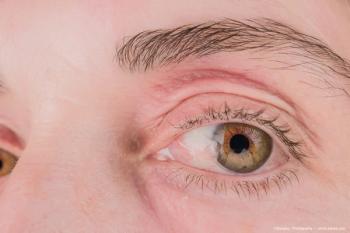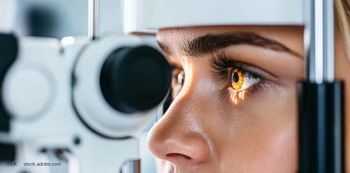
Lifitegrast data support dry eye efficacy over placebo drops
Lifitegrast ophthalmic solution 0.05% (Xiidra, Shire) has demonstrated positive results for the treatment of the signs and symptoms of dry eye disease. Eye dryness scores for some patients have improved after two weeks of treatment with the topical drop.
Reviewed by Cynthia Matossian, MD
Newly approved lifitegrast (Xiidra, Shire) has provided a useful alternative to cyclosporine (Restasis, Allergan) for some patients, said Cynthia Matossian, MD.
“We had a subset of patients with ocular surface disease who tried the existing medication, but for a variety of reasons, they were unable to tolerate it,” said Dr. Matossian, Matossian Eye Associates, Doylestown, PA. “Lifitegrast has helped that subset tremendously.”
More:
Dr. Matossian highlighted the results of the OPUS-2 and OPUS-3 phase III trials. Along with two other studies (OPUS-1 and SONATA), these trials provided the data which led the FDA to approve lifitegrast for treatment of dry eye.
Patients taking lifitegrast for 84 days reported a 10-point greater improvement in symptoms on a 100-point scale compared with those taking a placebo. About half of those taking lifitegrast experienced a treatment emergent adverse event, compared with a quarter of those taking the placebo, but most of these were mild.
In addition to topical cyclosporine, the only other FDA-approved medication for dry eye, options have included artificial tear substitutes, lubricant gels and ointments, nutritional supplements, corticosteroids, intense pulsed light, thermal pulsation therapy, and punctal plugs. Still, satisfaction remains elusive for some patients.
Related:
The difficulty in treating these symptoms may stem from the multiple factors. These can include age, hormonal status, genetics, gender, immune status, innervations status, nutrition, pathogens, and environmental stress.
Researchers believe these factors can create an imbalance between secretion and degradation of the tear film decreasing tear secretion, increasing tear evaporation, or altering tear film stability. This may result in desiccation and epithelial damage, triggering inflammation.
Both cyclosporine and lifitegrast are applied topically as eye drops and appear to work by modulating T-cells involved in the inflammatory cycle, Dr. Matossian said.
More:
Cyclosporine has been used to treat a variety of inflammatory diseases, including psoriasis, rheumatoid arthritis, ulcerative colitis, and ocular inflammation.
According to Clyde Shultz (Ophthalmol Eye Dis. 2014; 6: 37-42), it binds to cyclophilin in lympohcytes, inhibiting calcineurin, and ultimately preventing it from activating the transcription product of interleukin-2 which T-cells need to replicate.
Lifitegrast, on the other hand, according to the OPUS-2 authors (Ophthalmology. 2015; 122:2423-2431), is a “small-molecule integrin antagonist that blocks the interaction between intercellular adhesion molecule 1 and lymphocyte functional antigen 1, inhibiting T-cell adhesion, migration, activation, and subsequent cytokine release.”
Recent:
In the OPUS-2 and OPUS-3 trials, investigators recruited a total of 1429 patients with Schirmer Tear Test scores from 1 to 10 mm, eye dryness scores of at least 40 on a 100-point scale (where 0 is no discomfort), corneal stain scores of greater than 2, and history of artificial tear use within 30 days of the study entry.
Over a 15-day screening period, the participants received twice-daily doses of a placebo in both eyes.
The researchers then randomly assigned half the participants to twice-daily doses of lifitegrast 5.0% and the other half to placebo-buffered saline eye drops for 84 days. During the treatment period (days 0-84), subjects received twice-daily doses of lifitegrast ophthalmic solution 5.0% or placebo administered to the ocular surface as a single eye drop (in the morning and in the evening just before bedtime) in each eye.
At day 14, patients in both the lifitegrast and placebo groups reported improvements on the 100-point scale, but the improvement was 7.23 points greater for the lifitegrast group.
Related:
“This new medication delivered improvement in the eye dryness scores as early as 2 weeks in two study groups,” Dr. Matossian said.
At day 42, both groups continued to improve with a 9.75-point advantage for the lifitegrast group.
The improvements continued to day 84, with the difference between the groups holding more or less steady at 9.92 points.
At all these time points, the difference between the two groups was statistically significant (p < 0.0001).
Adverse effects, side effects
“There were few adverse systemic and ocular side effects that led to the discontinuation of the product,” Dr. Matossian said.
Forty-seven people in the lifitegrast group (6.6%) discontinued because of treatment emergent adverse events, compared with 12 (1.7%) in the placebo group. There were no serious ocular treatment-emergent adverse events.
Resident Writer:
“The two main side effects are instillation site irritation and dysgeusia, an unpleasant or medicinal taste in the back of the throat,” she said. “Some patients minimize the dysgeusia by pressing their their index finger against the inner corner of the eye. This step prevents the medication from getting into the lacrimal system that drains tears to the back of the throat.”
Other patients have dealt with the dysgeusia by gargling, chewing a mint, or eating food.
“Several of my patients have reported the dysguesia to improve over time,” said Dr. Matossian.
Related:
She also warns patients not to drive immediately after instilling the drops since some patients have experienced a transient blurring of vision lasting up to 15 minutes.
“Lifitegrast does not cause blurring all day; it’s a short-term blurriness, but we don’t have exact data on the average duration,” she said.
More insurance carriers are covering lifitegrast, accoding to Dr. Matossian.
“The take-home message is lifitegrast ophthalmic solution 5.0% is a new FDA-approved medication for the treatment of the signs and symptoms of dry eye, the first since [cyclosporine] was approved 13 years ago,” she said. “It’s nice to have at least two drugs in our armamentarium to treat dry eye disease.”
Recent:
Cynthia Matossian, MD
This article was adapted from Dr. Matossian’s presentation at the 2016 meeting of the American Academy of Ophthalmology. Dr. Matossian is a consultant for Allergan and Shire. She has also received research funding from Shire.
Newsletter
Don’t miss out—get Ophthalmology Times updates on the latest clinical advancements and expert interviews, straight to your inbox.













































.png)


